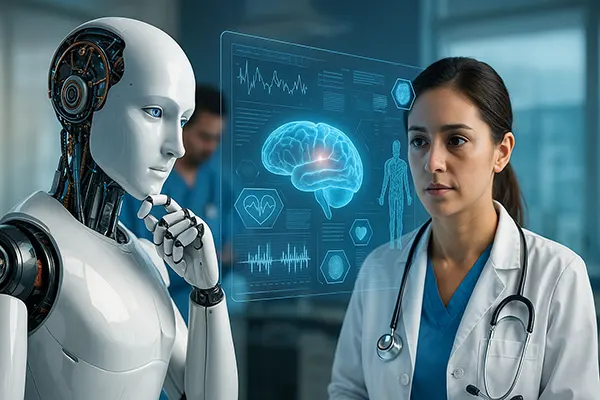
Artificial Intelligence in Healthcare: A Revolution in Diagnosis and Treatment
Artificial intelligence (AI) has firmly embedded itself into the modern healthcare landscape, offering innovative tools that redefine how diseases are diagnosed, treated, and managed. In 2025, the integration of AI technologies into healthcare systems has moved beyond pilot projects to become a standard part of operations in hospitals and clinics across the globe. With advancements in computing power and data analytics, AI is delivering real-world benefits to patients and clinicians alike.
AI-Powered Diagnosis: Accuracy and Speed
The application of AI in diagnostic processes has drastically reduced human error and improved early disease detection. Machine learning algorithms, trained on vast datasets of medical records and imaging scans, can now detect abnormalities such as tumours or genetic disorders with higher accuracy than traditional methods. In particular, tools like Google’s DeepMind Health are being used to spot diabetic retinopathy and age-related macular degeneration in eye scans with impressive reliability.
AI diagnostic systems have proven especially useful in radiology, where they analyse X-rays, MRIs, and CT scans much faster than human specialists. In 2025, AI is being integrated into systems like IBM Watson Health and Zebra Medical Vision, assisting doctors in detecting pneumonia, tuberculosis, and even COVID-19-related lung damage. These technologies support healthcare professionals rather than replace them, offering a second layer of verification and insight.
Beyond imaging, AI is now used in pathology and genomics to predict the likelihood of disease development. For example, AI-driven gene analysis helps identify cancer mutations early, allowing for more targeted and effective treatment plans. This capability is crucial for preventive care and significantly boosts survival rates for many chronic illnesses.
Clinical Decision Support Systems (CDSS)
AI-driven CDSS tools assist doctors in making data-informed clinical decisions. These systems analyse patient records, medical literature, and treatment guidelines to recommend personalised care strategies. In 2025, platforms like Tempus and PathAI are utilised in oncology to suggest optimal drug combinations based on genetic profiling and treatment history.
Such systems reduce cognitive overload for physicians, especially in high-pressure environments like emergency rooms or intensive care units. They also help minimise the risk of prescribing errors, which remain a leading cause of patient harm globally. By cross-referencing millions of patient cases, AI tools improve care consistency across diverse clinical settings.
Additionally, AI is being used to prioritise urgent cases, flag abnormal test results, and even generate automated follow-up reminders. These enhancements streamline operations, increase hospital efficiency, and improve the overall quality of patient care without requiring additional personnel.
AI in Treatment Planning and Personalised Medicine
AI plays a critical role in the development of personalised treatment strategies, adapting therapy plans to the specific needs of each individual. Oncology has been one of the most transformed fields in this regard. AI tools analyse tumour profiles and suggest precise treatment protocols that increase the likelihood of a successful response and reduce unnecessary side effects.
Pharmaceutical companies are also leveraging AI in drug development. In 2025, generative AI models simulate how new drug compounds interact with human proteins, speeding up discovery cycles. For instance, platforms like Insilico Medicine have produced promising leads for treatments of rare genetic diseases using AI-based compound generation and screening.
AI is also employed in robotic surgery systems. While a surgeon still guides the process, AI enhances precision by analysing real-time data from sensors and patient vitals. Tools like da Vinci Surgical System and newer models now include predictive alerts that anticipate complications before they occur, minimising risks and improving patient outcomes.
Remote Monitoring and Telemedicine
Remote healthcare has seen explosive growth since the COVID-19 pandemic, and AI continues to enhance its capabilities. In 2025, wearable health devices powered by AI monitor patients’ vitals 24/7, detecting anomalies like irregular heartbeats or oxygen drops in real time. These tools are especially useful for managing chronic conditions such as diabetes or hypertension.
Telemedicine platforms use AI to triage patient symptoms through chatbots or voice analysis. Companies like Babylon Health and Ada Health have integrated symptom-checking bots that guide patients to appropriate care levels. These systems are constantly refined using feedback loops and medical expert validation, ensuring their recommendations remain safe and accurate.
Moreover, AI can alert doctors if a patient’s remote data deviates from expected recovery patterns, allowing for proactive intervention. This capability reduces readmission rates and helps manage healthcare resources more efficiently, particularly in rural or underserved regions where medical staff are limited.

Ethics, Privacy, and Challenges of AI in Healthcare
Despite its benefits, AI in healthcare raises important ethical and privacy concerns. The vast amount of sensitive data required for training AI models makes data security a top priority. Regulations like the European Union’s GDPR and the U.S. HIPAA framework set strict guidelines for patient consent and data anonymisation, but enforcement and compliance remain challenging for many institutions.
Bias in AI algorithms is another critical concern. If training datasets lack diversity, the resulting models may produce skewed outcomes for minority groups. For example, dermatology AI tools trained mostly on lighter skin tones have historically underperformed in diagnosing conditions in patients with darker skin. Developers are now required to ensure representative data inputs and regular bias auditing.
There is also an ongoing debate about the role of AI in making life-and-death decisions. While automation aids efficiency, full autonomy in diagnosis or treatment is not universally accepted. Regulatory bodies like the FDA and EMA maintain strict oversight on AI-based tools, approving them only for supportive rather than primary clinical use in most scenarios.
The Human-AI Partnership
The future of healthcare lies not in replacing humans but in enhancing human capability through AI. Physicians equipped with reliable AI tools can focus more on empathetic care, patient communication, and complex decision-making that machines cannot replicate. The synergy of human intuition and machine precision forms the foundation of modern medical progress.
Medical education is also evolving. Universities now incorporate AI literacy into curricula for healthcare professionals, ensuring that future doctors understand algorithmic behaviour, data interpretation, and AI ethics. This shift prepares them to responsibly leverage AI in their practices without losing the human touch.
Ultimately, AI is a tool – a powerful one – but its success in healthcare depends on thoughtful implementation, ethical oversight, and collaboration between clinicians, patients, and technologists. When used responsibly, it has the potential to save lives and build more efficient, equitable healthcare systems worldwide.





